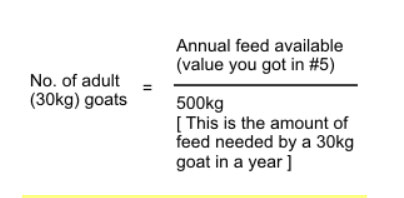- forages
- These are live plants eaten by goats which are either naturally growing or planted.
- They may be grasses, shrubs, tree leaves and food-feed crops that can be given as 100% of the animal's diet. Grasses and food-feed crops such as jackfruit, malunggay and katurai are forages that can be fed to goats
- crop residues
- These are waste products from crop production that can either be fresh or dried and can be fed to goats.
- These are seasonally abundant and often have low feeding value.
- They should constitute no more than half of the diet.
- concentrates
- These are commercial formulations or agro-industrial processing by-products that have concentrated amounts of nutrients.
- They are often given in small amounts because of their high nutrient concentration and cost.
As you assessed the resources available, you may have identified an existing area with forages, but is it enough to sustain your production target or the number of goats you intend to raise?
Note that native vegetation can only support 6-10 mature goats (30 kg body weight) per hectare. For you to generate income fast, you need to start with an economic-sized herd of 25 does. Thus for a herd of 25 does and their offspring, you will need at least 3ha of native vegetation for grazing. But do you have access to 3ha of land?
For your goat enterprise to be successful, you need to match your available inputs (especially feed) with your production target. To help you decide how many goats your current area can sustain and how much additional forage area you need to access or establish, go to your farm and do the following activity:
- Locate four areas in your farm where feed resources are available. Let these areas represent the different vegetation.
- Make a wooden quadrat measuring 1m x 1m. Simply tie the corners of four bamboo sticks to form a square and randomly throw this quadrat in each of the four locations in #1.
For example, if your farm has about 70% grasses and 30% shrubs, you will need to have 3 quadrants located at the grass area and 1 quadrant located at the shrub area.
- From within each quadrant, gather all the plant parts that can be eaten by your goats, such as the soft green leaves and herbaceous stems. Remove the non-edible parts such as the woody stems and old, yellow or brown leaves.
- Weigh all the plant parts that you have gathered.
- Compute the amount of feed available in each area for one year using the formula:
Example:
If for instance you were able to gather 5 kilos from your 1,000sq.m. area (measuring 50m x 20m), your computations will be as follows:
5kg ⁄ 4sq.m. x 1,000sq.m. = 1,250kg
- Compute the number of goats your area can support using the formula:
- If the amount of feed available from your existing area is not enough for your goats, you can determine how much area is needed for expansion using this formula:
Example:
The no. of goats your 1,000sq.m.area can support is computed as follows:
1,250 kg / 500 kg/goat = 2.5 goats
This means your 1, 000sq.m. area can accommodate only 2.5 goats. If you intend to raise 25, your computation will be as follows:
1,000kg / 2.5 goats x [(25 goats) - (2.5 goats)] = 9,000sq.m.
This means you need another 9,000 sq m. area for pasture establishment to support your production target.
Please note that the example given, where 5kg of edible plant parts is generated from 1000sq.m. area, is quite high considering that most backyard farms have only native vegetation naturally growing. For such farms, a realistic figure would just be between 1-2kg of edible plant parts. Farms, which are planted with a mix of improved grasses and leguminous trees and shrubs can get 5kg plant yield or even higher.
If your existing area is not enough to support 25 goats, ideally, you should start establishing your own forage garden. This will be very essential as you expand your operation.
However, if at the moment this is not possible, you can do any of the following
Option 1. Utilize available resources from within your farm and gradually introduce forages in farm, provided you:
- Start with fewer goats, and increase your herd as you build up your feed resources. This will delay your profits though.
- Gradually introduce additional forage species in your farm by planting improved forages that are adapted to your conditions.
These can support 20-50 mature goats (or a herd of 10-25 does with their offspring) per hectare and ensure year-round supply of the needed feeds.
If feed resources within the farm is limited, you can cut forages from other areas and haul them to your farm
This will require labor for hauling feeds and permission from the owner of the feed resource.
Option 3. Do a combination of Options 1 and 2.
Given the above option, select which plan do you want to adopt.










0 Comments